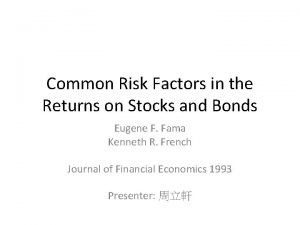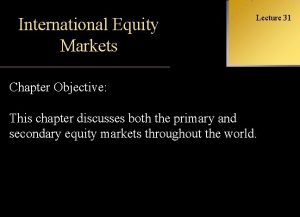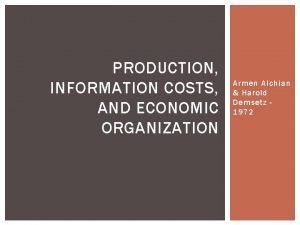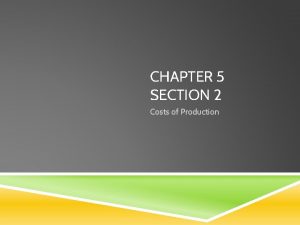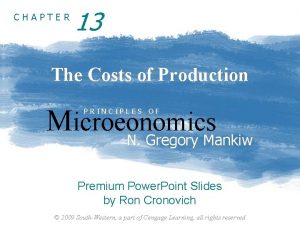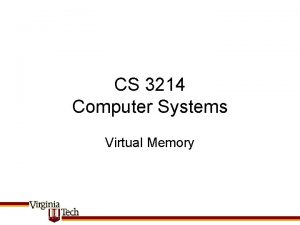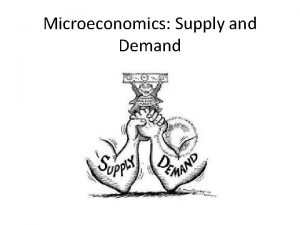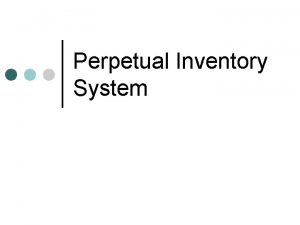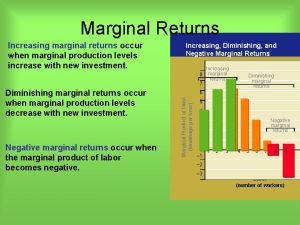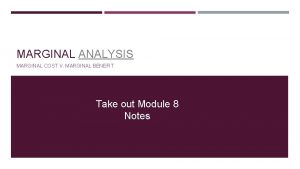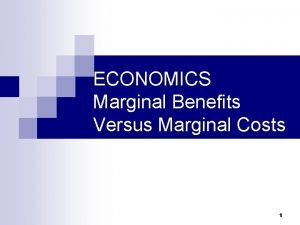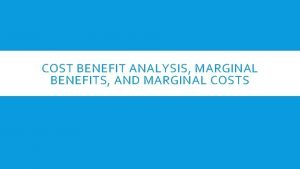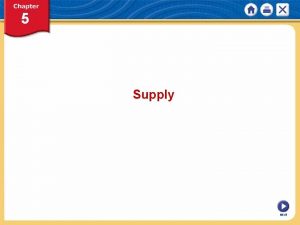Costs of Production FACTORS OF PRODUCTION MARGINAL RETURNS










- Slides: 10

Costs of Production FACTORS OF PRODUCTION & MARGINAL RETURNS

Labor & Output A fundamental question that every business owner must answer is how many workers to hire. With every new employee, the level of output that a business maintains begins to change. This is called the Marginal Product of Labor- the change in output from hiring one more worker.

As you hire more workers, your production goes up at first. But as you hire more and more, production begins to slow down and eventually decrease. Labor (# of Workers) Output (Baseball’s per hour) Marginal Product of Labor 0 0 - 1 4 4 2 10 6 17 7 23 6 5 28 5 6 31 3 32 1 31 -1 3 4 7 8 } }

Negative Decreasing Marginal Returns Return Increasing Marginal Returns

Production Costs To operate, business owners must pay expenses such as wages for their workers and capital to produce their goods. Production Costs come in two categories: Fixed Cost Does not change, no matter how much is produced Ex: Machinery + Variable Cost Changes as the quantity produced changes Ex: Wages, Resources = Total Cost Fixed & Variable Cost added together

Averages Fixed Cost, Variable Cost, and Total Cost can all be put on a per unit basis (Average Costs). Variable Cost. Quantity Average Variable Cost = Average Fixed Cost = Fixed Cost. Quantity Total Cost = Total Cost. Quantity Average

Marginal Analysis Marginal = Additional, extra. (One more unit) Therefore, Marginal Cost is the additional cost of producing one more unit. Change in Total Cost. Change in Output Marginal Revenue is the additional income from selling one more unit. Ideally, businesses will set output at the point where Marginal Cost = Marginal Revenue (price)!

} Setting Output Baseball’s per hour Fixed Cost Variable Cost Total Cost Marginal Revenue Total Revenue Profit Per Hour 0 $36 $0 $36 - $24 $0 $-36 1 $36 $8 $44 $8 $24 $-20 2 $36 $12 $48 $4 $24 $48 $0 3 $36 $15 $51 $3 $24 $72 $21 4 $36 $20 $56 $5 $24 $96 $40 5 $36 $27 $63 $7 $24 $120 $57 6 $36 $72 $9 $24 $144 $72 7 $36 $48 $84 $12 $24 $168 $84 8 $36 $63 $99 $15 $24 $192 $93 9 $36 $83 $119 $20 $24 $215 $97 10 $36 $106 $142 $24 $240 $98 11 $36 $172 $30 $24 $264 $92 12 $36 $173 $209 $37 $24 $288 $79

Graphing MC, AFC, AVC, and ATC

Practice with Clifford!
 Common risk factors in the returns on stocks and bonds*
Common risk factors in the returns on stocks and bonds* Yankee stock offerings
Yankee stock offerings Alir proses produksi
Alir proses produksi Types of cost savings
Types of cost savings Production, information costs, and economic organization
Production, information costs, and economic organization Production, information costs, and economic organization
Production, information costs, and economic organization Chapter 5 section 2 costs of production
Chapter 5 section 2 costs of production Active learning 3 calculating costs
Active learning 3 calculating costs Mmap returns ffff
Mmap returns ffff Law of diminishing returns
Law of diminishing returns Perpetual inventory system sales returns
Perpetual inventory system sales returns
